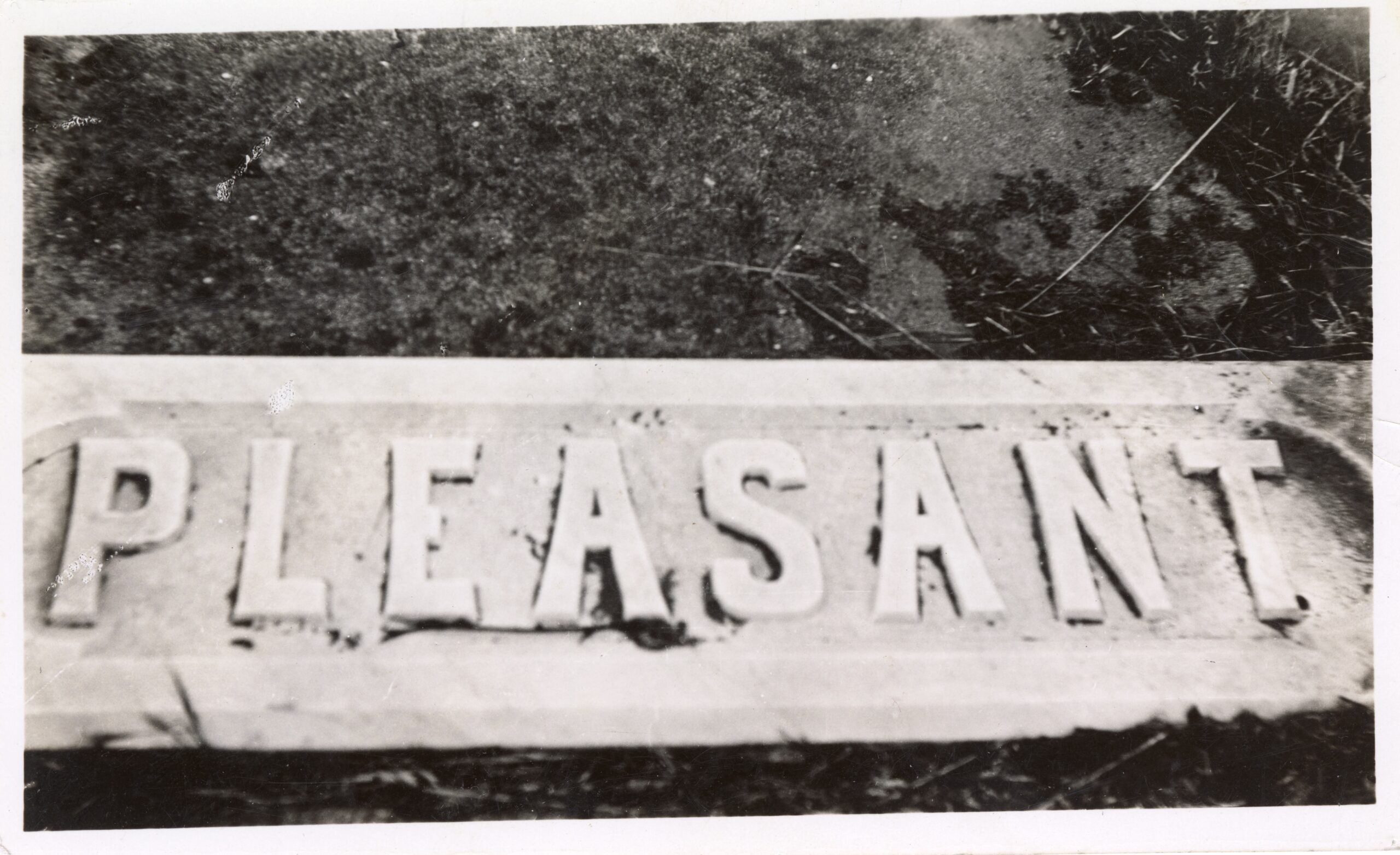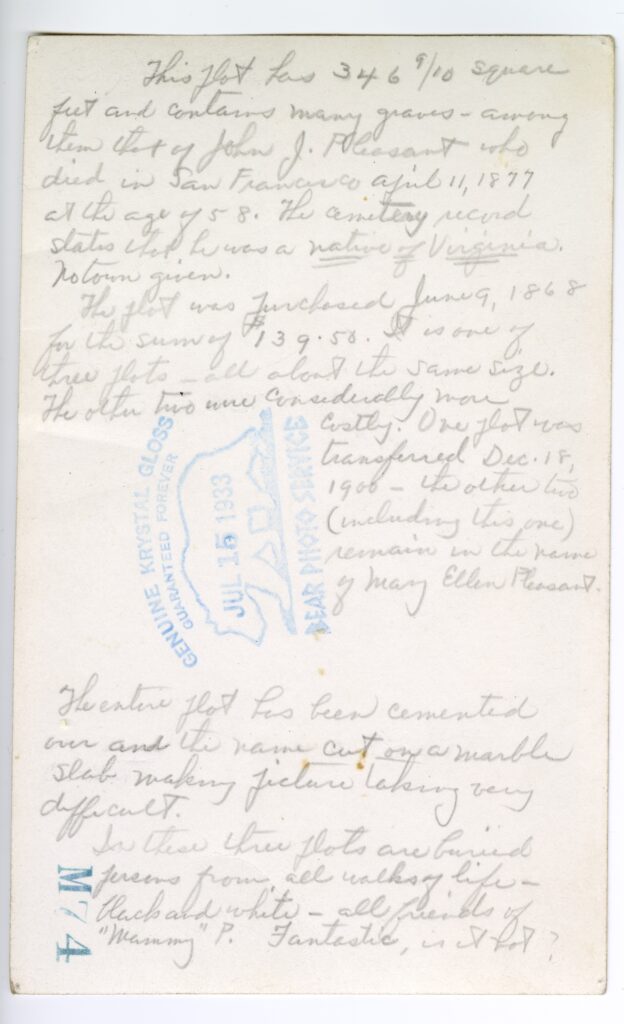John J Pleasants (the “s” was dropped after arriving in California), second husband to Mary Ellen, stated in the 1850 and 1870 federal census record that he was born in Virginia. William Willmore, son of an employee of MEP’s, stated John was born at “Contention” in Goochland County, Virginia. Willmore also referred to John J as “John James” in a 1938 interview with MEP biographer Helen Holderidge. Contention was the property of Virginia Governor James Pleasants. Review of the Virginia’s Free People of Color Registry (FPoC) finds a John Jilburn Pleasants matching his profile. In the Goochland County entries he is noted as having the alias John Gabbin (perhaps in reference to the story of Henri Christoph? see below), and in the Chesterfield County Order books as being 5’6″, a “bright mullatto” with light eyes, scars on his chin (and left groin). He states at each entry that he was born free in 1813.


data source: Virginia Untold: Free Registers
John traveled around the Richmond area in Goochland (1834-35) and Chesterfield Counties (1840-’44). Background on Virginia’s FPoC registry and requirements can be found here.
Some background on the “Pleasant(s)” family. The Pleasants were a prominent family in Virginia, particularly around Richmond. In the late 1700s, a white Quaker named John Pleasants III embraced the Abolitionist movement and desired to free the enslaved on his lands (after making himself wealthy). However, in 1771, it was not legally permissible while still a Colonial holding of the British Empire. However, Quaker John Pleasants III did include a clause in his will, stating that should it become legal to free his “slaves” he wanted his descendants to realize his wishes. At the time of his death, he held 212 enslaved persons valued at £10,000. His son, Robert, a staunch Abolitionist, did so in 1798. Robert had to sue many relatives who refused to honor Quaker John’s will. Robert brought a case to the Chancery Court in order to original people and their progeny. The Will specifically stated these people should be freed upon reaching the age of 30. John Marshall, future Supreme Court Chief Justice, presided over the case. You can read more about this case at this link and this one as well. link. In the end, approximately 300 formerly enslaved and their children and grandchildren were released; many retained the last name Pleasants.
Also, an important note – in 1806, Virginia enacted a law which required recently emancipated persons to leave the state within 12 months.
In Helen Holderidge’s and Susheel Bibbi’s books on MEP they both suggested that a man by the name of Louis Plaissance, the enslaved son of deceased Haitian King, Henri Christophe, was John J.’s father with a quadroon woman. For John J. to have been “born free” and remain in Virginia, his mother would’ve been emancipated prior to 1806, and her and Louis Plaissance’s names would’ve appeared in the Free People of Color registry; Louis Christophe’s (or any facsimile of it) does not. We do not know John J’s mother’s name. Holderidge noted that John J. only told the “Christophe story” to white people. However, William Willmore said that MEP was referred to as Madame Pleasants by the black populace even when she still publicly went by Mrs Smith.
It has been suggested that John, or Mary herself, was the daughter of Governor James Pleasants (1769-1836) or his son, John Hampden Pleasants (1797 – 1846), a Richmond publisher, and one of their enslaved women. The Governor and James were relatives of the Quaker John Pleasant and both men were born on the Contention plantation in Goochland County, west of Richmond. The Chancery Court records do not identify any of the Quaker John Pleasants III enslaved persons as living with James Pleasant; the Governor (a lawyer) did however, in the Chancery Court case, confirm the age of many of the enslaved individuals.
We are able however to learn the names of some of the enslaved at Contention from the Goochland Personal Property taxes for the 1781-1792. Below is an excerpt from 1784 which reveals 18 persons on his property. Interestingly the records for 1784 denote the number of his enslaved that have “white fathers“, the record denotes 3 and names them, Morocco, nan Betty (nanny?) and Lewis Dick. 1784 record also appears to name the others enslaved in his household, John, Olive, Patrick Baugha, Phill, Jacob, Beni John, Tab Milley, Nancy, Judah, Jae, Peter, Stephen, Mary, Morning, Patience, Nell & Sale.

Also living in Goochland in this era was Thomas Pleasants who did inherit some enslaved persons from Quaker John Pleasants. He emancipated those enslaved on his property in 1782 per Kathleen M Brown’s Undoing Slavery: Bodies, Race and Rights in the Age of Abolition (2023).
It is reasonable to suggest that Mr. John J Pleasants is more likely the child of one of the Quaker John/Robert Pleasants emancipated people of color who were liberated due to the 1799 Chancery Court decision. And that John J’s mother was liberated before the 1806 Virginia law which required resettlement of emancipated bondpeople outside the state. It is also possible he was the son of Governor James Pleasants who locally was known to have intimately interacted with the enslaved women at Contention, particularly in his later years. Again, however for John to stay in the state his mother would have been emancipated prior to his birth in 1813, and before 1806. Emancipation records for Contention enslaved women have not yet been identified to further vet this theory.
Virginia records indicate that in 1835 John J Pleasants married a Belinda Banks also of Goochland, VA. John and Belinda appear to have left Goochland in 1840 traveling forty miles to Chesterfield County south of Richmond, Virginia. Belinda would eventually remarry a Samuel Scott in 1855. She and Samuel appear to have been Quakers and adopted a girl named Caroline in 1867. Mrs. Scott ran a laundry in Henrico County, VA, outside of Richmond. She died in 1882 and is buried in Richmond, VA.
Mary said John worked for her first husband on his land near Harper’s Ferry; this is presumed to be in the 1840s. Unfortunately the FPoC lists for that now West Virginia county have not been located. In 1850, John is presumed to be in New Bedford, Massachusetts working as a waiter at the City Hotel.
IN 1851-52, John would travel to California, presumably before his wife Mary. His name appears in the 1868 San Francisco City Directory as a cook for the the Pacific steamship, the Orizaba.

Starting in 1865, John’s name is found on deed transfers and other legal paperwork with Mary’s in San Francisco and Chatham, Ontario.
Mr. John J Pleasant died of diabetes in 1877. He was initially buried in the San Francisco’s Lone Mountain/Laurel Hill Cemetery. His burial record states he was “of Richmond”. Another affirmation that the above cited person is Mary’s husband.

The photo below of John’s Memorial Tombstone was taken by John Brown scholar Boyd Stutler in 1933.

July 1933 Photo (close-up) taken of the John J. Pleasant grave plot and marker. Source: West Virginia Archives- John Brown/Boyd B. Stutler Collection
The flip-side of the Photograph:

The cemetery was closed to new burials in 1901 (hence why Mary isn’t buried with him). After many lawsuits, the burials were finally moved to Colma, California starting in 1940. Mr. Pleasant was re-interred in a mass grave. Link to virtual Colma Memorial
Funeral Record for John J Pleasant.
[

San Francisco, California, United States records, image 291 of 359; San Francisco Public Library. History Department